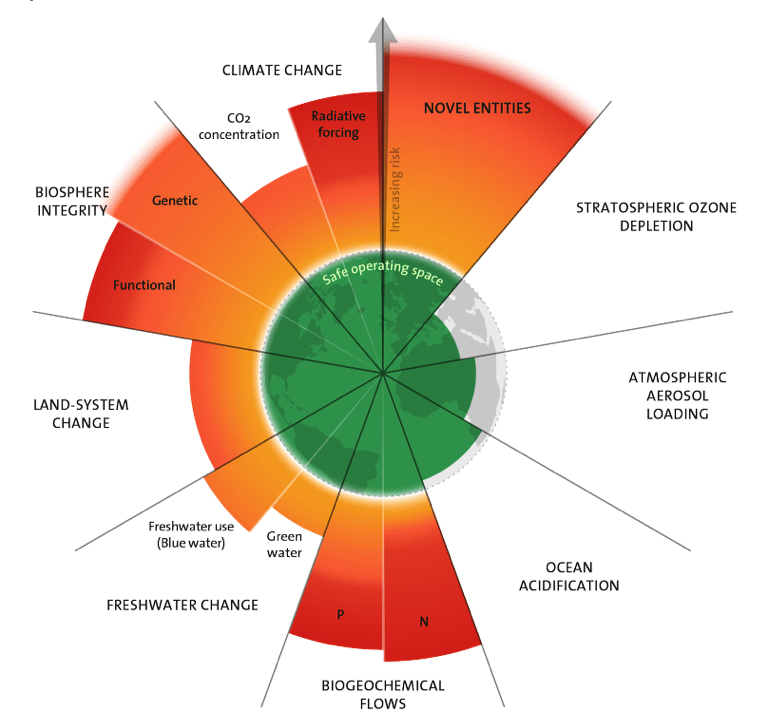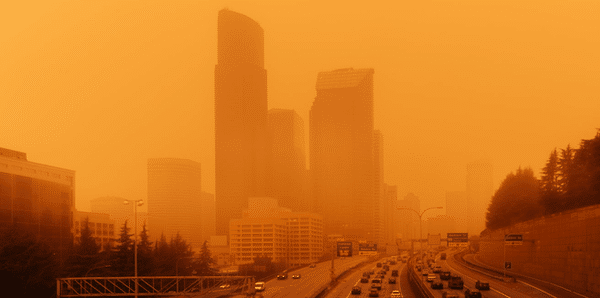From global warming to the biosphere and deforestation, from pollutants and plastic to nitrogen cycles and freshwater: Six of nine planetary boundaries are being crossed, while simultaneously pressure in all boundary processes is increasing, new research published in the journal Science Advances shows.

The 2023 update to the Planetary boundaries. Licensed under CC BY-NC-ND 3.0. Credit: “Azote for Stockholm Resilience Centre, based on analysis in Richardson et al 2023”. Download the illustration here.
“This update on planetary boundaries clearly depicts a patient that is unwell, as pressure on the planet increases and vital boundaries are being breached. We don’t know how long we can keep transgressing these key boundaries before combined pressures lead to irreversible change and harm,” says Centre researcher and co-author Johan Rockström, Director of the Potsdam Institute for Climate Impact Research (PIK) and Professor in environmental science at the Stockholm Resilience Centre at Stockholm University.
The new study is the third major assessment of the planetary boundaries framework, first introduced in 2009. It is the first to provide a complete check-up of all nine processes and systems that maintain the stability and resilience of our planet. While transgressing a boundary is not equivalent to drastic changes happening overnight, together they mark a critical threshold for increasing risks to people and the ecosystems we are part of.
We don’t know how long we can keep transgressing these key boundaries before combined pressures lead to irreversible change and harm.
– Johan Rockström, co-author and Centre researcher
Lead author Katherine Richardson, professor in biological oceanography and leader of the Sustainability Science Centre at the University of Copenhagen explains further:
“We can think of Earth as a human body, and the planetary boundaries as blood pressure. Over 120/80 does not indicate a certain heart attack but it does raise the risk and, therefore, we work to reduce blood pressure. The boundary for ozone depletion was exceeded in the 1990s but—thanks to global initiatives, catalyzed by the Montreal Protocol, this boundary is no longer transgressed.”
Aerosols, novel entities and freshwater
New scientific evidence now enables the team to quantify the boundary of atmospheric aerosol loading. This boundary is not transgressed yet, but rising pressures are evident in large regions where air particle pollution impacts monsoon systems.
The novel entities boundary has now been quantified, and the assessment confirms that it is transgressed. It includes the introduction and accumulation of all novel chemical compounds created by humans, such as microplastics, pesticides and nuclear waste.
Earth is a living planet, so the consequences are impossible to predict.
– Sarah Cornell, co-author and Centre researcher
The freshwater boundary now addresses both green water (invisible water, held in soil and plants in farms, forests etc.) and blue water (visible water in rivers, lakes etc)—both boundaries are transgressed.
As another first, a new approach for dynamically assessing biosphere integrity has been introduced. This reveals evidence of impaired functioning of ecosystems, showing that the boundary was already transgressed during the late 19th century when global agriculture and forestry saw their first major expansions.
Understanding the planet’s climate and ecosystems as a system
In light of these new outcomes, the researchers emphasise that Earth resilience goes well beyond climate change.
“The planetary boundaries framework helps scientists to track and communicate how these rising pressures are destabilizing our planet. Earth is a living planet, so the consequences are impossible to predict. That is why we are working more and more with policymakers, businesses and wider society to try to mitigate pressures on all boundaries”, stresses co-author Sarah Cornell of the Stockholm Resilience Centre at Stockholm University.
The boundary for ozone depletion was exceeded in the 1990s but—thanks to global initiatives, catalyzed by the Montreal Protocol, this boundary is no longer transgressed.
– Katherine Richardson, lead author
Deploying comprehensive computer models and simulations has played a major part in the study. Computer models of Earth system functioning are used to study interactions between climate and ecosystems in the biosphere. Simulations were done for several hundred years in the future to allow not just processes that react relatively quickly to change, but also the much slower Earth system processes that ultimately determine the outcome of environmental change caused today.
“Science and the world at large are really concerned over all the extreme climate events hitting societies across the planet as we move through the third human-amplified El Niño in only 25 years. But what worries us, even more, is the rising signs of dwindling planetary resilience, manifested by the breaching of planetary boundaries, which brings us closer to tipping points, and closes the window to having any chance of holding the 1.5°C planetary climate boundary,” Johan Rockström says.
The new planetary boundaries assessment underlines the tight and complex links between people and planet. It gives a basis for more systematic efforts to protect, recover and rebuild Earth resilience.
“Ultimately, it highlights the environmental consequences of living in the Anthropocene, and our responsibility as future stewards for the planet”, concludes co-author Ingo Fetzer of the Stockholm Resilience Centre at Stockholm University.

